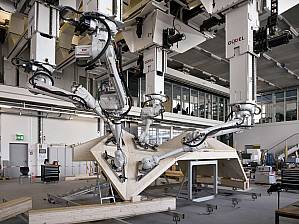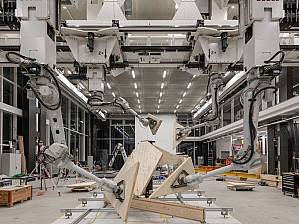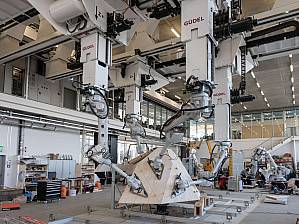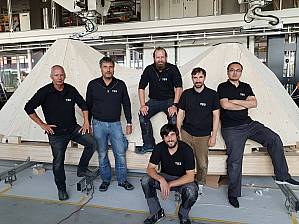The hanging gardens of Zug
30. Nov 2021
For the Tech Cluster Zug, researchers from ETH Zurich are building a planted architectural sculpture together with Müller Illien landscape architects, Timbatec and other partners. The 22.5 meter high structure consists of five geometrically complex wooden shells and is currently being produced by robots at ETH.
For the Tech Cluster Zug, researchers from the group of ETH architecture professors Fabio Gramazio and Matthias Kohler are building a planted architectural sculpture together with Müller Illien landscape architects, Timbatec and other partners. The 22.5-meter-high structure consists of five geometrically complex wooden shells that are supported - slightly offset from each other - by eight slender steel columns.
Joint grouting without pressure
Always in sync, four suspended robotic arms pick up the wooden panel assigned to them, perform a high-precision dance and finally place the panels in space according to the computer design. An algorithm calculates the robots' movements in such a way that no collisions occur. Once the machines have placed their four panels next to each other, they are first temporarily joined by craftsmen and then bonded together with a TS3 casting resin. In this way, the cross-laminated timber panels can be joined to each other on the face side by joint grouting without applying pressure. Timbatec developed this process in several research projects with the ETH Zurich and the Bern University of Applied Sciences. Today, it is mainly used for the construction of floor slabs, but also enables structures such as Semiramis. Thus, between 51 and 88 such wooden panels are joined together to form a wooden shell.
In contrast to traditional timber construction, robotic manufacturing has several advantages: On the one hand, the robots relieve humans of the heavy lifting and exact positioning, and on the other hand, costly, resource-intensive substructures can be dispensed with in the assembly process.
A symbol of cooperation
Robotic prefabrication is currently running at full speed. The individual shell segments are continuously being transferred to Zug on trucks and the architectural sculpture will then be erected and finally planted in spring 2022. From summer 2022, it will be possible to view the wooden structure from the ground and buildings and catch a glimpse of the greened shells. The slender and tall structure will be lushly planted with large shrubs and trees, giving it a stately weight of its own. At the same time, it represents a large attack surface for the wind. Thanks to the advantageous round shape of the shells, it is guided around the structure. Nevertheless, the stiffening of the structure with its eight slender columns is a challenge. The wind pressures on the shell were calculated with a fluid mechanical RWIND simulation from Dlubal Software, which simulates the flow around the structure in a wind tunnel. In addition, due to the slender construction, resonance effects along and across the wind direction had to be considered in the calculations.

In the classic design process, architects try to take into account the different requirements of a building or structure in the design and then adjust it until all of them are met as well as possible. Not so with Semiramis: a customized machine learning algorithm, developed in collaboration with the Swiss Data Science Center, showed the researchers sophisticated design options. The proposals differed in terms of the shapes of the trays and their spatial arrangement relative to each other, but also showed how each design affected individual target variables, such as irrigation of the trays. "The computer model allows us to reverse the conventional design process and explore the full design scope for a project. This results in new, often surprising geometries," says Matthias Kohler, professor of architecture and digital fabrication at ETH Zurich.
In the "Immersive Design Lab," an augmented reality laboratory on the Hönggerberg campus, the researchers were able to explore the designs in three dimensions and continue working on them together in real time. Software developed jointly with ETH's Computational Robotics Lab also allows them to easily adjust the designs of the wooden shells: For example, if the scientists move a single point within the geometry of one of the shells, which are composed of around 70 wooden panels, the software adjusts the entire geometry. At the same time, it takes into account the relevant manufacturing parameters, such as the maximum possible weight of a panel, and thus always generates the most efficient and resilient configuration.
Source: ETH Zurich







